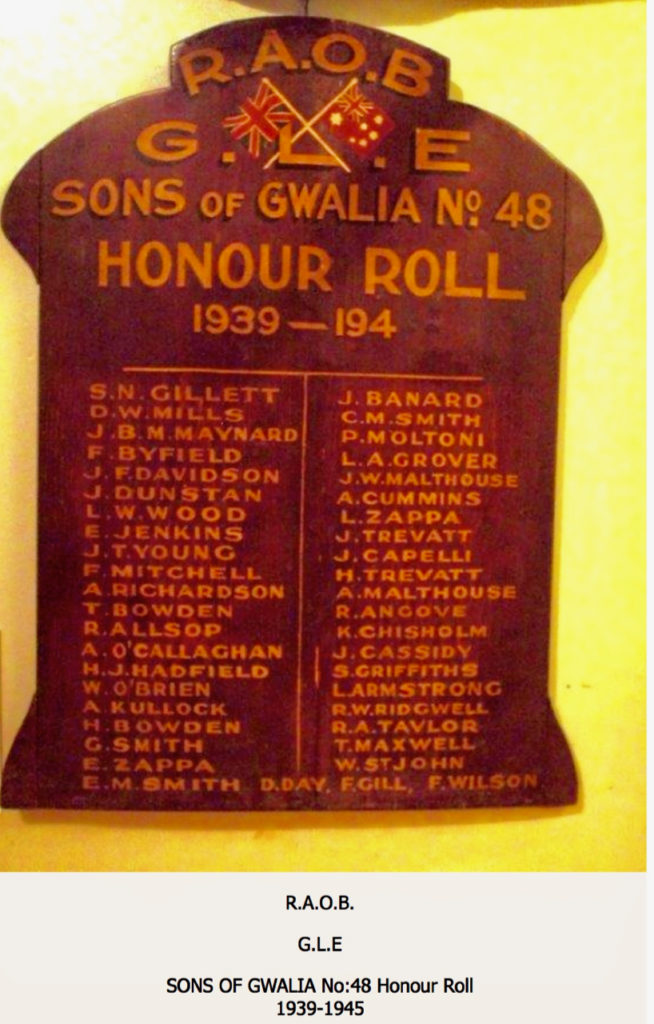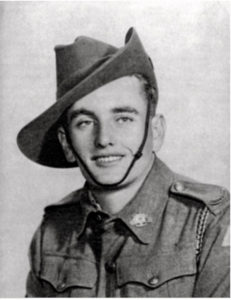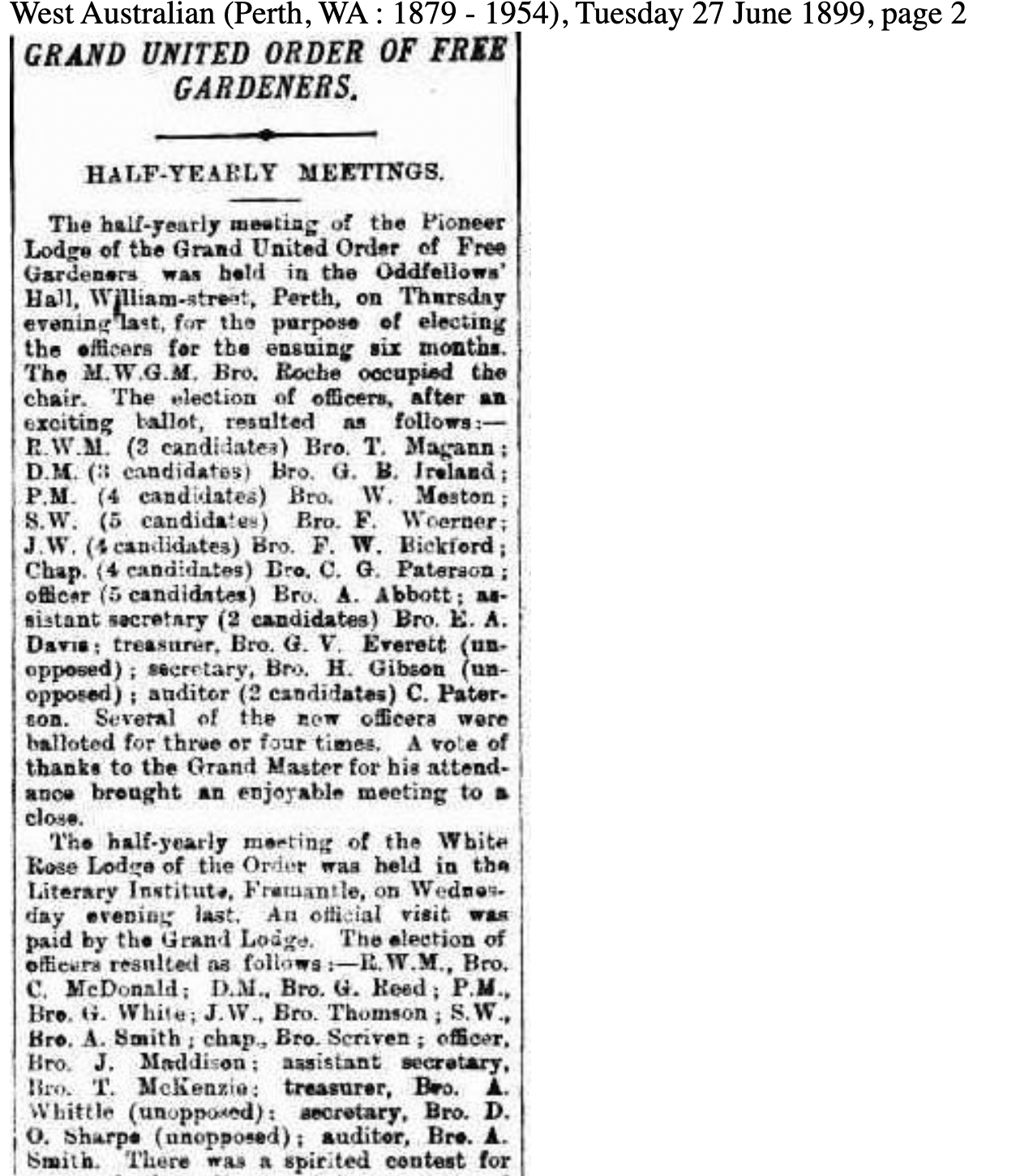ROYAL ORDER of BUFFALOES – CHANGI LODGE, SINGAPORE WW2


There were 38 members at this Lodge from the 2/4th – originally members of Lodges in WA – often found in more remote mining/rural towns.
So what is a Buffaloe or Buff and what did they do?
‘The order started in 1822, and known as “The Buffs” to members. The Order provides aid to its members, their families, dependents of former members, and other charitable organisations.’
‘R.A.O.B. is a fraternal organisation raising funds to help charities and their own members in a time of need.’
‘Our aims are to come together for entertainment, whilst raising money and other benefits for charity. The only obligations on our members are to respect each other and to respect our traditions.’
Most country towns and older Perth suburbs could say they had a FREMASONS OR RAOB Lodge which in today’s world is no longer being used for Lodge Meetings – some have become community halls and many sold.
Membership of such clubs is no longer popular as it was before WW2 and for the few decades after.
Please go to this website for an overview of various types of Lodges
The RAOB at Sons of Gwalia created a WW2 Honour Board.

Please read further about the 2/4th men honoured on this board.
Below: Wiluna, 1938

Below: Sons of Gwalia 1938


Below: Mt Magnet 1934

Below: Norseman 1938

Below: Koorda 1938

Below: Midland RAOB now used for new purposes.



The Grand United Order of Free Gardeners was first established in Western Australia in 1898. WX4934 Ronald Arthur Page, known as Ron or Darkie was a member of the Wattle Branch, Victoria Park.

Ron lost his life on the first Sandakan March having reached Ranau, he died of starvation and illness on 17 Feb 1845 aged 26 years.


The Grand United Order of Free Gardeners Friendly Society provided medical, funeral benefits, and loans for educational or housing expenses as well as providing a Fraternal Lodge for like minded men.
‘The Grand United Order of Free Gardeners & Other “Free” Orders
It may surprise many Freemasons to know that they are not the only “Free” Order based on old trades and guilds. Over the centuries we have seen the Free Shepherds, Free Gardeners, Free Colliers, and Free Carpenters among many others. Of these, the only one which seems to have survived the ravages of time are the Free Gardeners. Among all the major Orders on this page, this is the only one which seems to pre-date Freemasonry, and one of the most difficult to gain information about. The earliest records of the Free Gardeners go back to a “Fraternite of the Gairdener’s of East Lothian” in 1676. This original Fraternity was to be joined by another “Fraternite” at Dunfermline in the early eighteenth century. Like Masonic Lodges, the Free Gardeners lodges began as operative bodies but soon began to accept nonoperatives. It was not until the late eighteenth century that the Gardeners began to take off as independent lodges. In the mid-19th century there were various attempts to form a national Grand Lodge, resulting in an Eastern and a Western Grand Lodge being formed but with many lodges remaining without the authority of either. The Free Gardeners spread into England and across the sea to the United States and Australia. In the early 1980’s the Curator of the Museum & Library of the Grand Lodge of Scotland, Robert Cooper, noticed that much of the regalia stored for the museum did not appear to be Masonic at all. After much research into the matter he wrote a book entitled “A History of the Ancient Order of Free Gardeners” which is taken as the authoritative work on this Order. Today, the Free Gardeners operate in Australia as a Friendly Society in Western Australia.’
Official information taken from the only existing group remaining in Australia today, in Victoria:
https://www.historyatwork.com.au/blog/2014/10/8/the-grand-united-order-of-free-gardeners
‘The Free Gardeners originated thousands of year ago in the vineyards and gardens of King Solomon’s newly built temple on Mount Zion. As they gradually broke away from bondage and went searching for work they were often helped by colleagues encountered on their travels. Over time a bonded fellowship developed that enabled members to rely on other members for protection, assistance and benevolence. They became the Order of Free Gardeners.
In the 19th century bonded fellowship morphed into a concept known as mutual aid and was regulated by the Friendly Societies Act. They provided medical and funeral benefits, and loans for educational or housing expenses. They were able to help thousands of families throughout the turn of the century, the Great Depression, two world wars and into the 21st century. In 2006 the Australian Prudential Regulation Authority removed all of their financial responsibilities and with that, the majority of their members.
This group remain the only Free Gardeners in the Southern Hemisphere and one of only a handful around the world. In their 150th year in Victoria, they are still seeking opportunities to serve the community and continue their history of benevolence, friendship, belonging and community service.’


